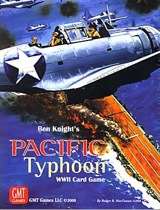Pacific Typhoon – Card Game Review
 Pacific Typhoon. GMT Games.
Pacific Typhoon. GMT Games.
Designed by Ben Knight. $40.00
Passed Inspection: Low complexity, fairly fast-moving, attractive components.
Failed Basic: Frequently results in no combat; type can be difficult to read against background colors on cards.
The Force Cards represent the aircraft, surface ships and submarines deployed in the battle.
Pacific Typhoon is a trick-taking game for 3–7 players, based on naval conflicts in the Pacific Theater in World War II. Allied and Japanese aircraft, surface ships and submarines engage one another in historical conflicts from Pearl Harbor to Savo Island to Okinawa. Pacific Typhoon is more game than simulation, but it is provides a history lesson on the conflicts and events that shaped our present day.
{default}Components
Inside the box you’ll find 40 Battle Cards, 110 Force cards, two six-sided dice and a rulebook. The cards and dice are held in a plastic tray, a nice addition since many contemporary games seem to ship without thought for storage or care of the components.
The Battle Cards represent the various areas of operations where you’ll wage combat. The information printed on these cards includes the year the battle took place, whether it is a daytime or nighttime engagement, victory and resource points, and an icon regarding the rules for Fate, described below. A photograph from the historic battle and accompanying text adds flavor.
The Force Cards represent the aircraft, surface ships and submarines deployed in the battle, as well as bonus cards and event cards that turn the tide of war. Like the Battle Cards, the Force Cards have a year, day or night restrictions, victory points, photograph, flavor text and Fate icons. They also show combat values and nationality. A shape, such as an aircraft windscreen or a binocular or periscope view, determines which bonus cards may be played in conjunction with the fighting unit.
The 24-page rulebook is divided into numbered sections, which facilitates reference during the game. It also has several examples of how to play and a key for all the information printed on the cards. At the end of the book are Developer and Designer notes.
Rules, Mechanics and Game Play
If you’ve ever played War with a deck of cards or played the commercial game Top Trumps then you will feel at home with Pacific Typhoon. The game is played in 20 identical rounds. At the start of a round, a hand of six Force Cards are dealt to each player. As the game progresses, players amass resource points, allowing them to draw up to 9 cards. The round leader turns over the top two Battle Cards and selects which will be used, discarding the other. The leader then reads aloud the year, day or night battle conditions and the suit (described below).
All players must then play Force Cards that fall within the year and day or night conditions. Battle and Force cards with a light blue background indicate a daytime battle, while a black background means a night battle. A yellow background is twilight; the round leader chooses whether it will be considered as day or night.
The round leader then plays a Force Card. The card must have the same year printed on it as the Battle Card and must be able to conduct combat in the current day or night conditions. As an example, the escort carrier Gambier Bay has a light blue background and can be used in 1944 or 1945, but if the current Battle Card is Surigao Strait, a night battle in 1944, the Gambier Bay could not be played because it can only be used during daylight battles.
[continued on next page]


Andy Lewis, VP of Design,Development and Events for GMT Games, sent in the following information:
As a point of clarification, if even one person played a card that had a combat value of 1 or greater that survived the round, then it’s NOT declared No Combat. You’re right that a lot of combats can end with only one side being played, but there’s still a fight because people are playing a higher value for the winning side to get the spoil, which is the Battle card.
Rarely, if ever, do we see a winning margin of 30 points; 30 points in a seven-player game is a good total score. The players need to negotiate to keep scores close. If the leading player picks the battle and plays the first card, the rest of the players need to work to make sure the leader doesn’t win the battle and get to assign the spoils.